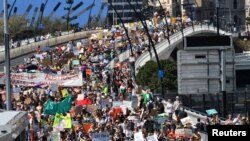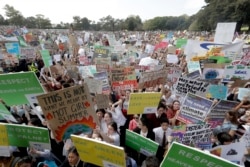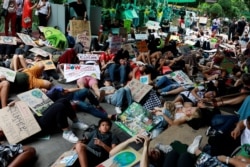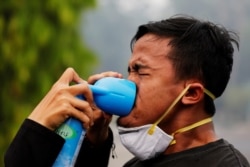The Associated Press contributed to this report.
SYDNEY/BANGKOK — Thousands of students took to the streets of Australia and other Asia-Pacific countries Friday to kick off a global strike demanding world leaders gathering for a U.N. climate summit adopt urgent measures to stop an environmental catastrophe.
“We didn’t light it, but we’re trying to fight it,” read one sign carried by a student in Sydney, as social media posts showed huge demonstrations around the country, including outback towns like Alice Springs.
“The oceans are rising and so are we,” read another sign held by a protester wearing school uniform in Melbourne.
Protests inspired by the 16-year-old Swedish activist Greta Thunberg are planned in about 150 countries Friday as people rally to demand governments take immediate action to limit the harmful effects of manmade climate change.
Rally at UN headquarters
The strike will culminate in New York when Thunberg, who has been nominated for a Nobel Peace Prize for her climate activism, will spearhead a rally at the United Nations headquarters.
Thunberg noted the “huge crowd” in Sydney in a tweet, which she said would set the standard as the strikes moved across Asia, Europe and Africa.
By early afternoon, the Sydney protesters were overflowing out of a 34-hectare (84-acre) open space in the city. Similar crowds were reported in Brisbane and other state capitals.
Organizers estimate more than 300,000 protesters took to Australian streets in what would be the largest demonstrations the country had seen since the Iraq War began in 2003.
Protests were staged in 110 towns and cities across Australia, with organizers demanding government and business commit to a target of net zero carbon emissions by 2030.
School Strike 4 Climate said 265,000 protesters turned out at demonstrations in seven Australian cities alone. The largest crowd was an estimated 100,000 in Melbourne, followed by 80,000 in Sydney.
Danielle Porepilliasana, a Sydney high school student, had a blunt message for politicians like Australian Finance Minister Mathias Cormann, who told parliament Thursday that students should stay in class.
“World leaders from everywhere are telling us that students need to be at school doing work,” she said, wearing anti-coal earrings. “I’d like to see them at their parliaments doing their jobs for once.”
Rising seas
The U.N. summit brings together world leaders to discuss climate change mitigation strategies, such as transitioning to renewable energy sources from fossil fuels.
The issue is vital to low-lying Pacific islands, which have repeatedly asked wealthier nations to do more to prevent rising sea levels.
Children in the Solomon Islands rallied on the shoreline wearing traditional grass skirts and carrying wooden shields in solidarity with the global movement.
In Thailand, more than 200 young people stormed into the Environment Ministry and dropped to the ground feigning death as they demanded government action on climate change.
“This is what will happen if we don’t stop climate change now,” said 21-year-old strike organizer Nanticha Ocharoenchai.
The Thai Environment Ministry’s deputy permanent secretary, Adisorn Noochdumrong, supported the students.
“This is how the young people express their concerns, which we deem as a good sign and not at all a nuisance,” he said.
Marching in heavy smog
In Palangka Raya, in Indonesia’s Central Kalimantan province, youths carrying placards marched through heavy smog caused by forest fires.
In the eastern Indian city of Kolkata around 25 school children handed out flyers at busy bus terminals and held placards that read “Save Our Planet. Save Our World.”
“This is the only planet we have. We wanted to stand for it before we went to school for the day,” one of the children said.
No protests were authorized in China, the world’s biggest source of greenhouse gas emissions, but Zheng Xiaowen of the China Youth Climate Action Network said Chinese youth would take action one way or another.
“Chinese youth have their own methods,” she said. “We also pay attention to the climate and we are also thinking deeply, interacting, taking action, and so many people are very conscientious on this issue.”
Global warming caused by heat-trapping greenhouse gases from burning fossil fuels has already led to droughts and heat waves, melting glaciers, rising sea levels and floods, scientists say.
Carbon emissions climbed to a record high last year, despite a warning from the U.N.-backed Intergovernmental Panel on Climate Change in October that output of the gases must be slashed over the next 12 years to stabilize the climate.
Organizers said demonstrations would take different forms around the world, but all aim to promote awareness of climate change and demand political action to curb contributing factors.









